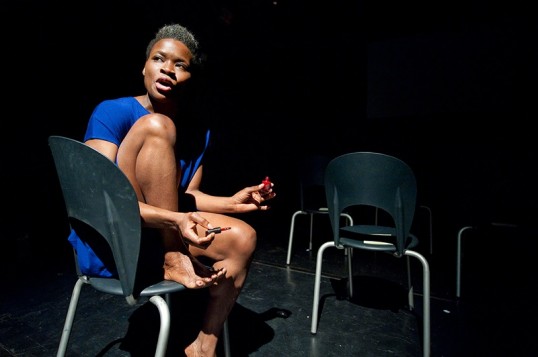Review – HeLa
★★★★☆ Immortality unsought
Summerhall (Venue 26) Fri 2 – Sat 26 August 2013
Review by Irene Brown.
Summerhall’s anatomy theatre is the perfect location for Adura Onashile’s revelatory one woman play about Henrietta Lacks, whose body cells have been vital to modern medicine.
As the audience fills the wooden seats in the steep auditorium, Onashile chalks a series of esoteric four lettered initials on a blackboard, gradually crossing them all out. All that is except the last: HeLa. That is for the first two letters from a patient’s first and last names. Henrietta Lacks.
The 31 year-old Lacks died of ovarian cancer in Baltimore in 1951. Months earlier she had been to the coloured section of the John Hopkins Hospital with stomach pains. The biopsy taken there revealed her diagnosis.
The tumour also provided a sample of her cells which, unlike any other human cells, were able to grow and replicate outside the human body. This so-called HeLa cell line has been used as the basic tool for scientists to test the effects of everything from vaccines to glue on the human body.
HeLa has played a vital part in nearly every major medical advance over the seven decades since Henrietta’s death. And the growing of new HeLa cells has been commercialised. Critically, Henrietta was never asked if her cells could be used in this way; she never gave her consent.
Inspired by ‘The immortal life of Henrietta Lacks’ by Rebecca Skloot, Onashile uses sound, visuals, movement, dance and direct narration to reveal this shocking piece of secret history.
Onashile performs barefoot and vulnerable in elegant cream that is a cross between a nurse’s uniform, a tunic and just a lovely dress to accommodate her character changes through which she mutates like Henrietta’s cells. At times she lies prostrate then writhes heart stoppingly on the theatre’s old wheeled trolley, representing either Henrietta in her agony or as her fast dividing HeLa cells.
A form of eternal life on earth
Her calm and dignified narration gives the list of men – mostly men and mostly white men – who went on to win prizes and acclaim for research into polio vaccines, cryogenics, genetics, space travel, cloning, ethics, cancer, HIV, gene mapping and most recently genome thanks to Henrietta’s unique cells while the Lacks’ family were kept out of the loop unable to afford health care. Their images appear on the screen as the story unfolds.
Henrietta Lacks’ story is shocking as part of the history of the poor, but especially as part of the history of poor black people, part of which was tests made on slaves without anaesthetic on the pretext of their being given ‘treatment’.
While Henrietta died young and poor, the terrible irony is that part of her still lives in the form of this cell. The character of her daughter finds some solace in her mother having a form of eternal life on earth. There is a visual fast back at the end to 1951 ending with an old image of the woman that was Henrietta Lacks, née Loretta Pleasant. A rather lovely smiling human face at last put to the anonymous code.
Up until now, this woman had inadvertently been a means to scientific ends, albeit vital ones. She only becomes human to the nurse taking samples from her dead body when she happens to notice her bright painted toenails.
Images of cells dance the ceiling like wobbly stars during this disturbing and challenging watch that sheds light on a vital piece of human history. It is an uneasy watch but an important piece of writing that throws into relief moral questions about race, poverty and the ethics of the ownership of human tissue that have been ignored for too long.
Running time 1 hr.
Run ends Mon 26 August 2013
Daily (not 7, 20), 6.30pm.
Venue 26, Summerhall, 1 Summerhall Edinburgh, EH9 1PL
Tickets from: www.edfringe.com/whats-on/dance-and-physical-theatre/hela
The Summerhall website: www.summerhall.co.uk




















Comments (2)
Trackback URL | Comments RSS Feed
Sites That Link to this Post